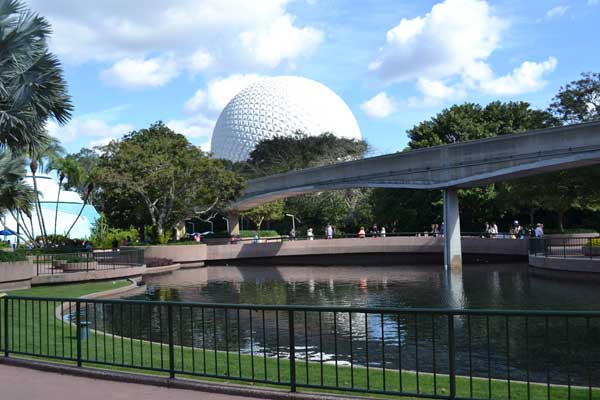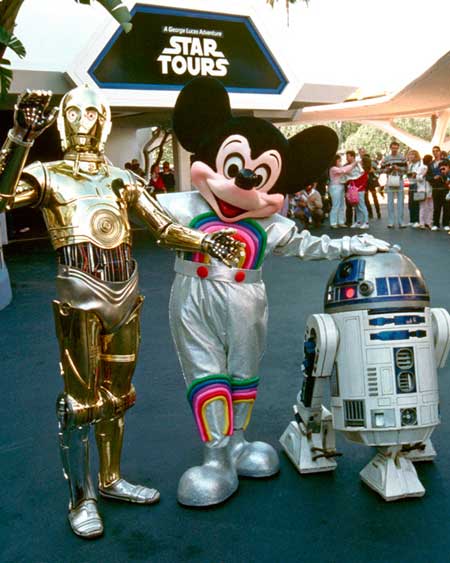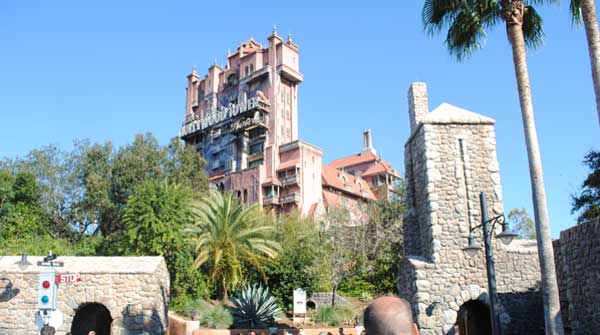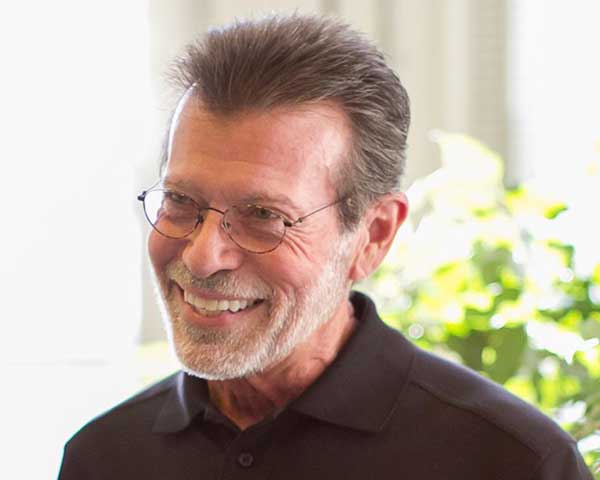If you’re a fan of the music of Disney’s theme parks, you’ve enjoyed the work of Composer Richard Bellis. His extensive work for Disney goes back to arranging music for the opening of EPCOT Center. Since that point, he’s written music for diverse attractions including the original Star Tours and Indiana Jones Adventure at Disneyland. Bellis also composed for extinct Walt Disney World attractions like the ExtraTERRORestrial Alien Encounter, Captain EO pre-show, and the Lights, Motors, Action! Extreme Stunt Show (still in Paris). Bellis was kind enough to answer my questions by e-mail about his diverse career as an award-winning composer.
As I learn more behind-the-scenes details, I’m more impressed by what it takes to create an attraction. A perfect example is how Bellis describes challenges writing for a live performance like the Indiana Jones Epic Stunt Spectacular. I also enjoy the way that Bellis talks about the differences between writing for television versus theme parks. Bellis also worked on the Twilight Zone Tower of Terror, Reflections of China, and the Mexico pavilion’s score. There was far too much to cover, but it was still incredible to hear about Bellis’ work on Disney attractions.
Interview
How did you get started writing music when you were young?
I had a piano teacher unlike most. During my lesson, we would sit together on the piano bench and he would write out eight measures of a standard tune like “Stardust”. These arrangements introduced me to contemporary chords and gave me a first-hand view of someone writing music. Meanwhile, my dad, a former dance band leader, had become a junior high school band and orchestra teacher and just happened to be MY teacher. I asked him what was involved in taking these “cool” chords I was learning and writing them for other instruments. He taught me the ranges and transpositions of various instruments and I started experimenting. Soon I had formed a band and was writing the arrangements. From there I continued to write arrangements for big bands and finally professionally for singers, Las Vegas acts, etc.
Can you describe your history with Disney’s theme parks? Did you visit Disneyland much when you were younger?
Yes. I first visited Disneyland when I was around 10 years old. I don’t remember the exact year, but it was shortly after the park had opened and probably around 1956. After that, we used to go every other year or so. The Peter Pan ride, Tea Cups, Frontierland, E tickets, etc. and lots of music, probably all from Buddy Baker.
I had been a child actor. In those days, the 1950s, kids who were actors had to be able to tap dance or sing or play an instrument. I auditioned to be one of the original Mouseketeers and was selected on a Thursday with instructions to report to the Disney lot for work on the following Monday. I got the measles on Saturday. Only decades later when I was having lunch with Buddy during his time directing the scoring program at USC did I find out that the person I would have auditioned for WAS Buddy.

What made you interested in composing scores for the entertainment field, particularly for theme parks?
One of the arranging jobs introduced me to George Wilkins with whom I formed a writing partnership. When Buddy was thinking about retiring from Disney, George was brought in to work with Buddy as the heir apparent. One day, George called me to ask my availability because there was a lot of work to do for something called EPCOT, a new Disney park in Florida. I became one of a small cadre of arrangers for the park. After that project was finished (it’s never really finished) I received my first offer to do an attraction as music director which meant arranging, orchestrating and some original music. It turned out to be quite an attraction! Star Tours. Tom Fitzgerald was the producer.
One of my favorite topics is the original EPCOT Center at Walt Disney World. What were some of your projects for that park?
I worked on “Tomorrow’s Child”, Spaceship Earth, and the Imagination Pavilion. It’s hard to remember the other titles.
You worked on music for two classic Disneyland attractions adapted from popular film franchises, Star Tours and Indiana Jones. What was it like to work from the existing John Williams music to develop the scores for those attractions?
An education to say the least. The Indiana Jones Stunt show was interesting. The stunt performers would be rehearsing and I would have to be on the “playing field” to time, with a stopwatch, each segment in order to edit the music to fit the individual stunts. As the stunt people rehearsed, they would get better and more comfortable with the stunts, which would change the timings. So, we had a trailer parked on the stage in which we had one of the very first digital editing units. Very primitive.
We would make edits on the spot and then run the playback while the performers would do the stunts then return to the trailer, re-edit and try again. All this prior to coming back to California, preparing the final orchestrations and re-recording portions of the Williams’ score. This also meant creating a sophisticated method of triggering the various score segments in the event that something went wrong during the performance. It has always been the case that working for the parks puts one on the bleeding edge of technology.

One of my favorite music cues is the “Announce Chime” introduction in Star Tours, which sets just the right mood. How did that track come together?
That was not intended to be any kind of “iconic” signature. It was merely a part of the audio environment of the preshow. I, of course, was influenced by the Close Encounters motif but just looked for five notes that were in major and sounded idiomatic. It was interesting when the news broke that Michael Giacchino was going to do the current version, fans of the attraction blogged their concern about whether or not the “Announce Chime” would be lost.
Michael, who I think is terrific, replied that he would never want to replace that chime as it had become so iconic. Who knew? The other piece of music written for a “scene” in the preshow which was never created is The Droid’s Room. The setting was supposed to be a workshop where many droids are repairing and working on various parts of the spacecraft. The final use was in a “boombox” next to one droid doing repairs. But the cue made it on to a number of the park CDs.
You also composed the score for the Lights, Motors, Action! Extreme Stunt Show, which is now only in Paris. What were some of the challenges you faced when trying to time the music cues to the work of live performers?
The Motors stunt show opened in Paris of course. The timing problems here were similar to the Indy stunt show except more variable but also decades later so technology was available to deal with them. Because this show deals with action sequences, the music was more rhythmic. That meant when you broke it into sections, when each section triggered, it had to come in on the right beat of the measure — usually the first beat of a new bar.
This had to be done live so the options were to hire several different musicians (divided into shifts) to hit PLAY at exactly the right time or create a system by which a machine operator could watch for a visual cue — a motorcycle passing a certain landmark — hit PLAY and the machine would wait for the next downbeat before it started to play. That was the solution. The only other challenge was having to walk around the stands tweaking the music mix during a very cold, windy day in November.
A forgotten gem that has many fans is the ExtraTERRORestrial Alien Encounter, which opened in The Magic Kingdom in the mid-‘90s. What was it like to work on such a different type of scary attraction for Disney?
The fun part was creating the music including the song “Seize the Future” on which my wife, Gloria Kaye, sang and we processed her voice. Much of the wonderful electronic-effect music was masterfully performed by Ed Kalnins. The installation was a lot of sitting around due to the fact that there were so many mechanical things that could go wrong and often did. But, you’re right, it was scary and that was its eventual and unfortunate demise.

You’ve also composed music for many film and TV projects. What is the biggest difference between writing music for thee parks versus movies and television?
Working conditions mostly. Example: When I first scored the Tower of Terror for Florida, the speakers were located in the elevator shaft which meant we mixed the music in the studio. When the attraction opened in California, technology now allowed the speakers to be located in the elevator car so, we strapped a ProTools rig into the elevator car and attempted to mix while we dropped…and dropped…and dropped. We had the same kind of back-breaking experience while timing the Indiana Jones Adventure ride in California. Much more physically demanding than writing for film and TV. That’s what made the China Pavilion and the Mexico Pavilion so relaxing.
Finally, you wrote a book called The Emerging Film Composer: An Introduction to the People, Problems, and Psychology of the Film Music Business, which was released back in 2007. What made you decide to write this book, and how did it come together?
I spent 13 years teaching courses in film and TV music scoring at USC. That coupled with years of experience working in the field resulted in a lot of information that needed to be purged. A book seemed like the best way to accomplish that.
Thanks to Richard Bellis for taking the time for this interview! Learn more about his work at richardbellis.com.
Related Articles
Interview with Compose Bruce Broughton (Tomorrow Society Podcast, Episode 33)
Interview with Composer Paul Leonard-Morgan (Tomorrow Society Podcast, Episode 45)
Celebrate the Future: An Epcot Playlist
Stay updated on all the latest blogs and podcasts; join The Tomorrow Society today!
This post contains affiliate links. Making any purchase through those links supports this site. See full disclosure.




I have to virtually shake the hand of this amazing composer! Richard, if you’re reading this, know that I was listening to an old EPCOT center CD in my car a few months ago, and heard “Tomorrow’s Child” for the first time in years. Had to pull over into a movie theater parking lot because the tears wouldn’t stop flowing. Spaceship Earth represents hope in mankind’s best characteristics, and that song delivers the message perfectly. I first heard it when I was 11 or 12 years old, and I felt so inspired. Now I am doing things that make a real difference in the world. I love that I can now bring my own daughter on Spaceship Earth, but I’m sorry she cant’ have the same experience I did. Thank you for all the musical gems!
Melanie, it was a treat to connect with Richard and learn more about his work. I knew about a lot of it but was surprised by how many attractions Richard worked on over the years. I didn’t even cover all of it in the questions!